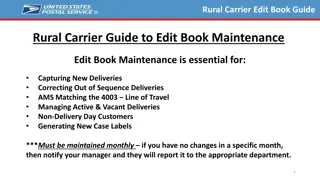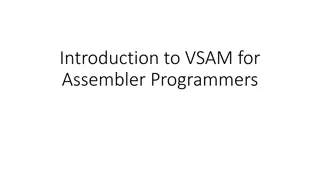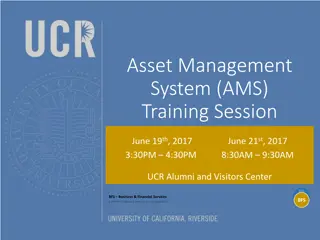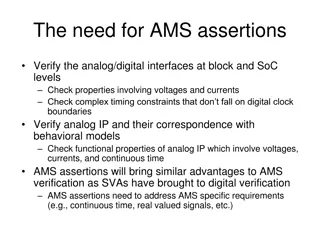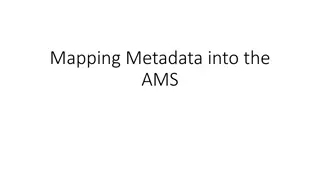
Introduction to Industrial Information Systems and MRP in Industry
Dive into the world of Industrial Information Systems (IIS) with a focus on Material Requirements Planning (MRP) in industry. Explore the importance of information flow, MRP, MRP II, ERP, and MES in enhancing efficiency in production processes within industrial firms.
Download Presentation

Please find below an Image/Link to download the presentation.
The content on the website is provided AS IS for your information and personal use only. It may not be sold, licensed, or shared on other websites without obtaining consent from the author. If you encounter any issues during the download, it is possible that the publisher has removed the file from their server.
You are allowed to download the files provided on this website for personal or commercial use, subject to the condition that they are used lawfully. All files are the property of their respective owners.
The content on the website is provided AS IS for your information and personal use only. It may not be sold, licensed, or shared on other websites without obtaining consent from the author.
E N D
Presentation Transcript
King Saud University College of Engineering IE 462: Industrial Information Systems Fall 2018 (1st Sem. 1439-40H) Introduction (Chapter 1) part 2 Introduction to Industrial Information Systems (IIS) Prepared by: Ahmed M. El-Sherbeeny, PhD 1
Lesson Overview Part 2: MRP / MRP II ERP MES ERP/MES/Control Information flow within the IS Network Architecture Functions of an Information System 2
Why IS in Industry? An industrial firm is a set of activities, or processes, that interact with each other (creating and exchanging information) Example: the fact that quality control has given final approval to use material is information passed on to production before production personnel can process the material IE462 3
Material Requirements Planning (MRP) as an IIS MRP represents a typical instance of IIS for inventory/production management Input to the MRP is the Master Production Schedule (MPS) through sales order or warehouse stock replenishment request MPS contains how much and when (gross requirements) of finished product units (see e.g. below) IE462 4
Material Requirements Planning (MRP) as an IIS (cont.) The demands for subassemblies and components are determined through Bill of Materials (BOM) explosion. The demand of raw materials are determined from subassemblies and components demands The demand for raw materials are fulfilled either from stock or through purchase requisitions IE462 5
Material Requirements Planning (MRP) as an IIS (cont.) IE462 6
Material Requirements Planning (MRP) as an IIS (cont.) MRP II is an extension of MRP for the inclusion of capacity planning (resources planning: workers, machines, etc.) required to meet the manufacturing activities MRP II answers the question of whether or not a sufficient week-by-week plant capacity exists to meet the planned production schedule IE462 7
MRP MRP II IE462 8
Enterprise Resource Planning (ERP) The standard MRP system has been expanded to include much more functionality within a concept known as enterprise resource planning (ERP). In addition to the traditional MRP, ERP has added support for some of the following functions: - Quality management - Sales and distribution - Human resource management - Project management IE462 9
Enterprise Resource Planning (ERP) cont. More recently, ERP was extended beyond the factory and the firm to include functions that link the company to its customers and suppliers, such as the following: - Logistics supply chain management - Inter-company communications - Electronic commerce IE462 10
Manufacturing Execution System MRP / MRPII / ERP are generally considered as planning systems. They are not very well integrated into the execution of production The absence of available software solutions for production execution in the shop floor has led to the development of the manufacturing execution system (MES) MES manages resources (materials, machines, and personnel, etc) on a daily or hourly basis. IE462 11
MES functions Typical MES functions include the following: Dispatching and monitoring production : controlling the release of work orders to the shop floor and tracking work-in-process inventory. Detailed scheduling Data collection from factory floor operation to provide a history of factory events Quality data analysis: real-time analysis of manufacturing, notifying out-of-tolerance values, and sometimes recommending corrective action. IE462 13
ERP/MES/Control: A hierarchy of Information Systems in the Industrial Plant A hierarchy of decisions must be made in manufacturing, from the machine, or unit operation control level, up through the overall planning of plant operations. IE462 14
ERP/MES/Control: A hierarchy of Information Systems in the Industrial Plant (cont.) IE462 15
Production Line or Work Cell Level Control the interactions between a group of related machines or processes This level of decision making is concerned with the release and delivery of materials at the correct time Examples of decisions at this level include routing of material among machines, and the decision to extract out-of-specification components while they are being processed The work cell or production line level is considered part of the MES level, but there is some overlap with the controls level IE462 16
The Nature and Role of IIS The industrial system is modeled as a hierarchy of decisions, where the upper levels of the hierarchy place constraints and control decisions on each succeeding lower level The complete integration of all levels of decision processes, supported by computer information systems, is the domain of an industrial information system IE462 17
Information Flow within the IS ERP, MES & Control are standard software solutions ERP provides the MES level with an overall plan of what is to be produced during the current planning horizon The MES level is then responsible for detailed production operations on the factory floor. IE462 18
Information Flow within the IS (cont.) The MES level tells the machine controllers how to produce a particular part by controller programs As production is executed, actual results concerning what was produced are fed back to the planning level. The MES level monitors real-time actual results, and data summaries are logged for storage in factory databases. IE462 19
Coordinating the Layer Interaction in the Industrial Information System IE462 20
Network Architecture Enterprise integration is about the integration of functional areas through information sharing To realize efficient information sharing, it is desirable to network the levels of the hierarchy of the manufacturing enterprise The network architecture is a description of how the various layers of the decision hierarchy will communicate with one another The network architecture is typically implemented with the use of local area networks (LAN) IE462 21
Typical Network Architecture for Modern Industrial Company IE462 22
Functions of an Information System Data collection: captures data about events affecting the system and its environment, and loads data into input devices Collected data are classified and indexed in order to make retrieval of desired information easy Data storage: storing past data and information into database for future retrieval. Information retrieval: database management system extract necessary processed data as information for decision making IE462 23
Functions of an Information System (cont.) Data processing: computation or summarization, includes all transformation process on input data into information Data / information transmission: communication of coded information between geographically separated points Data display: presentation of output information in a form for human perception, by means of printed form, or temporary display on CRT display, etc. IE462 24




